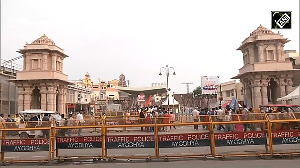Sanjay Labroo, the 41-year-old football-crazy managing director and chief executive of Asahi India, often talks about his worst-case scenario.
In five years, he says, Asahi India may only have 75 per cent of the market for automotive glass.
Labroo has been making similar predictions for the last five years but he has, so far, stayed ahead of the game. Asahi India lords over the Indian automotive glass industry with an extraordinary 90 per cent marketshare.
It's a slightly different story at Floatglass, a company he took over two years ago. Floatglass came to Labroo's fold with its accounts soaked in red. But, after a two-year struggle, that is about to change.
Floatglass, which was initially controlled by Asahi Glass of Japan, makes glass used for buildings. It's in third spot in the booming segment after Gujarat Guardian, the market leader, and Saint Gobain.
Labroo's association with Floatglass began in September 2001 when Asahi Glass of Japan decided to bring its two ventures in India, Asahi India and Floatglass, under one company.
While it owned 75 per cent in Floatglass, it had a 24 per cent stake in Asahi India, the same as the Labroo family. (Maruti Udyog owned 12 per cent.)
While Floatglass had run up heavy losses, Asahi India was thriving. Asahi Japan decided to place the fate of Floatglass in Labroo's hands too.
Thus, Asahi India acquired the 75 per cent stake of Asahi in Floatglass. Asahi India did not pay anything for the Floatglass stock.
Instead, it took over the debt worth Rs 453 crore (Rs 4.53 billion) on the company's books, a large chunk of which was from Asahi Japan. The Japanese company wrote it off, which brought down Floatglass' debt down to around Rs 192 crore (Rs 1.92 billion).
Asahi India followed this up with an open offer for another 25 per cent Floatglass shares, in keeping with the Takeover Code of the Securities & Exchange Board of India. This took Asahi India's stake in the company to 80 per cent.
Shortly afterwards, Floatglass was merged into Asahi India. One of the drivers for the merger were the accumulated losses of almost Rs 200 crore (Rs 2 billion) on Floatglass's books, which Asahi India, a company taxed at the peak rate, could use for tax advantages. (The merger brought the stake of Asahi Japan and the Labroo family down to 22.21 per cent each, while Maruti Udyog's stake declined marginally to 11.10 per cent.)
Labroo's first challenge was to turn around the business he had acquired. The Floatglass plant at Taloja had totted up huge losses. But Labroo has already streamlined production and plugged losses.
The Taloja plant's production is up from 29 million square metres two years ago to 31.5 million square metres this year. When the current financial year ends in March 2004, Labroo expects the plant to show an operating profit of over 25 per cent.
An inefficient plant wasn't the only problem. The acquisition of Floatglass and its subsequent merger brought three brands into the company's portfolio -- Asahi India, Asahi Float and Tata Float. (Asahi Japan had acquired the 75 per cent stake in Floatglass from the Tatas. One of the legacies of the old order was the brand Tata Float.)
This led to some confusion in the market. Though glass is still largely perceived as a commodity in India, it is not so in the global markets. Companies like Saint Gobain and Guardian enjoy tremendous brand equity.
As a result, Labroo unveiled a common corporate brand, Asahi India. This was followed by a campaign featuring supermodel Katrina Kaif.
The impact was visible soon: before it had embarked on its brand building exercise, Asahi India had to sell its floatglass at a discount of 2 per cent to 5 per cent as compared to its rivals. Not any more.
"All the discounts have stopped. We have been able to establish Asahi India as a brand in the market," says Labroo.
And it is on the strength of its brand that Labroo hopes to take on Saint Gobain and Gujarat Guardian. To be sure, putting up capacities quickly is not the answer. Floatglass is a continuous process industry and the capital investments are large.
So capacities need to be built gradually, in tandem with the rise in demand. Still, Labroo has his gameplan ready for building fresh capacity.
"In the next four years, three new float glass plants will be required. One of these will be ours. In the next five years, six will be required -- two will be ours," he says.
At the moment, the north has emerged as the main driver for float glass demand in the country. It accounts for 31 per cent of the total floatglass demand in the country. South and west account for 27 per cent each, while the east accounts for 15 per cent.
However, none of the existing capacities are in the north -- while Saint Gobain's production unit is in Tamil Nadu, Gujarat Guardian's factory is located in Gujarat and the Asahi India plant is at Taloja in Maharashtra.
So Labroo expects a lot of fresh capacities, including his own, to come up in the north.
Float glass consumption in the country is low -- at 0.56 kg per person per annum, it is one-seventh of China, one-tenth of Thailand and one-twenty eighth of the whole developed world.
With the construction boom happening across the country, Labroo expects the demand for floatglass to grow at a fast clip: 11 per cent to 12 per cent per annum over the next five years.
The floatglass initiatives do not mean Labroo has lost sight of his bread and butter automotive business.
In November, he announced that Asahi India would set up its third plant in Chennai to manufacture automotive glass. (Its existing automotive glass plant is at Rewari, Haryana.)
The new plant will initially have a capacity of over 500,000 laminated windshields and will tentatively cost over Rs 50 crore (Rs 500 million), to be funded primarily internally.
The new plant will cater to existing customers in South India. These include Hyundai Motors, Toyota Kirloskar, Ford India, Hindustan Motors (Lancer Project), Volvo India, etc.
Besides, the company will be seeking to address some export markets using the new facility.
This is where Labroo's big opportunity could lie. Established in 1907, Asahi Japan is one of the world's top glass producers with a market share of 45 per cent in Japan, 20 per cent in North America and 25 per cent in Europe.
Moreover, it is the global market leader in automotive glass with a market share of 30 per cent. Over the years, Asahi India has emerged the lowest cost producer of automotive glass in Asahi's network in 24 countries.
Labroo is in negotiations with the top brass of Asahi Japan to work out how this advantage can be leveraged by Asahi India. If that works out Asahi India could be revving up for a drive around the world.






 © 2025
© 2025